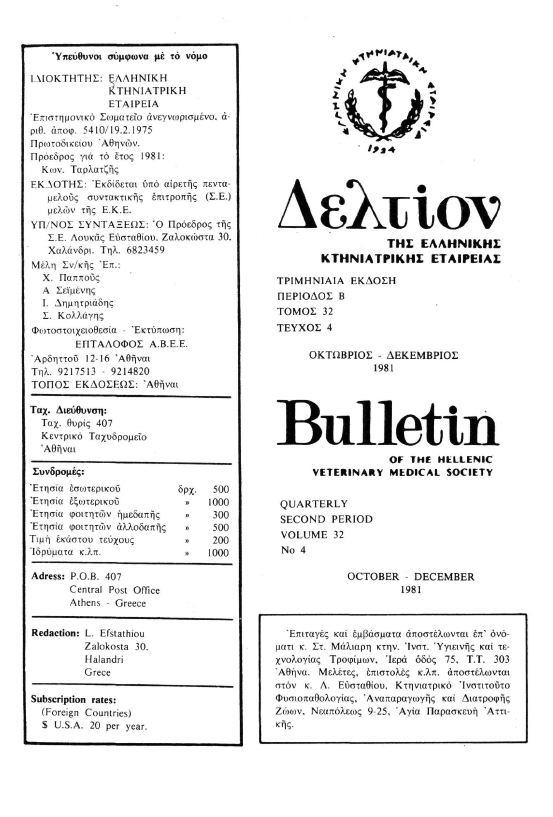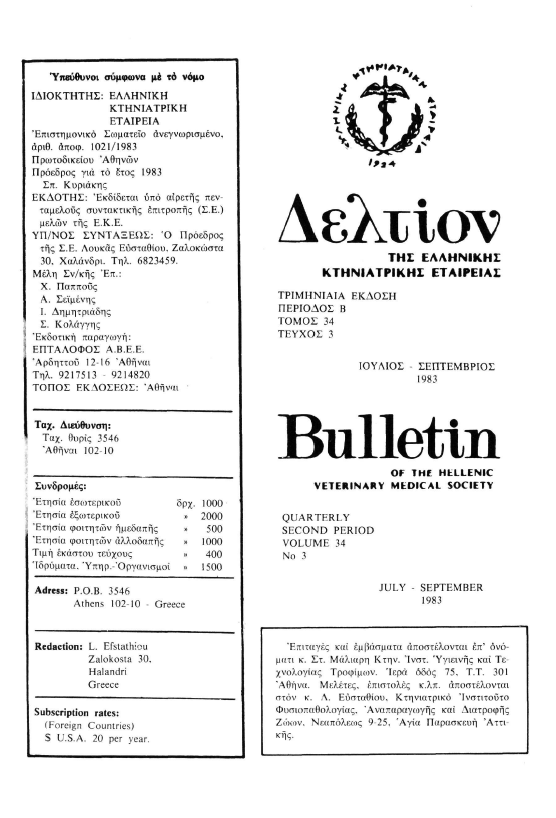Ή γονιμότητα κατεψυγμένου σπέρματος ταύρου πού διατηρήθηκε έπί 11- 12 χρόνια
Περίληψη
Σέ 34 αγελάδες σ' ένα σταυλο έγινε τεχνητή σπερματέγχυση μέ σπέρμα κατεψυγμένο, άπό 5 διαφορετικούς ταύρους, σέ αμπούλες του 1 ML επιλεγμένες άπό 450 πού διατηρήθηκαν 11-12 χρόνια στό υγρό άζωτο (-196°C) και γέννησαν συνολικά 14. Ή μέση γονιμότητα τοΰ σπέρματος των ταύρων βρέθηκε ϊση μέ 46,2%. Τήν ίδια περίοδο σέ 88 αγελάδες του ίδίου σταύλου έγινε σπερματέγχυση μέ σπέρμα κατεψυγμένο ρουτίνας, άπο 8 ταύρους τοΰ K.TJC καί Ν.Α 'Αθηνών, σέ πλαστικούς σωληνίσκους τών 0,5 ML πού διατηρήθηκε τό πολύ 1 χρόνο στό υγρό άζωτο (-196°C) καί γέννησαν 59 αγελάδες. Ή μέση γονιμότητα τού σπέρματος τών 8 ταύρων βρέθηκε ϊση μέ 68,90%. Ή διαφορά αυτή τών μ.Ο τών δύο περιπτώσεων, αν καί σημαντική 22,7% στατιστικά (δοκιμασία t) βρίσκεται στό οριο 5% (t:2,18 d.f 11 Ρ~ 0,05). Το δείγμα τοΰ σπέρματος 11-12 ετών είχε ένα μικρό αριθμό παρατηρήσεων. 'Εάν υπήρχε ένα πιο αντιπροσωπευτικό δείγμα ή διαφορά αυτή θά ήταν ασφαλώς στατιστικά σημαντική. Ή πτώση αυτή τής γονιμότητας τού σπέρματος τοΰ ταύρου σέ άμποΰλες πού διατηρήθηκε 11-12 χρόνια σέ υγρό άζωτο (-196°C) έκτος άπό τήν πυρινική δράση πού γίνεται στην κεφαλή τοΰ σπερματοζωαρίου, πρέπει νά οφείλεται καί σέ κάποιο γηρασμό τών ένζυμων τής καλύπτρας τών σπερματοζωαρίων, τών υπευθύνων γιά τήν γονιμοποίηση.
Λεπτομέρειες άρθρου
- Πώς να δημιουργήσετε Αναφορές
-
ΚΑΡΑΤΖΑΣ Γ., & ΧΑΤΖΗΣ Ν. (2019). Ή γονιμότητα κατεψυγμένου σπέρματος ταύρου πού διατηρήθηκε έπί 11- 12 χρόνια. Περιοδικό της Ελληνικής Κτηνιατρικής Εταιρείας, 32(4), 324–328. https://doi.org/10.12681/jhvms.21511
- Τεύχος
- Τόμ. 32 Αρ. 4 (1981)
- Ενότητα
- Άρθρα

Αυτή η εργασία είναι αδειοδοτημένη υπό το CC Αναφορά Δημιουργού – Μη Εμπορική Χρήση 4.0.
Οι συγγραφείς των άρθρων που δημοσιεύονται στο περιοδικό διατηρούν τα δικαιώματα πνευματικής ιδιοκτησίας επί των άρθρων τους, δίνοντας στο περιοδικό το δικαίωμα της πρώτης δημοσίευσης.
Άρθρα που δημοσιεύονται στο περιοδικό διατίθενται με άδεια Creative Commons 4.0 Non Commercial και σύμφωνα με την άδεια μπορούν να χρησιμοποιούνται ελεύθερα, με αναφορά στο/στη συγγραφέα και στην πρώτη δημοσίευση για μη κερδοσκοπικούς σκοπούς.
Οι συγγραφείς μπορούν να καταθέσουν το άρθρο σε ιδρυματικό ή άλλο αποθετήριο ή/και να το δημοσιεύσουν σε άλλη έκδοση, με υποχρεωτική την αναφορά πρώτης δημοσίευσης στο J Hellenic Vet Med Soc
Οι συγγραφείς ενθαρρύνονται να καταθέσουν σε αποθετήριο ή να δημοσιεύσουν την εργασία τους στο διαδίκτυο πριν ή κατά τη διαδικασία υποβολής και αξιολόγησής της.






